
Architecture matters
One of the biggest limitations of healthcare IT is that much of it is located within on-premise servers. While much of business enterprise software has moved to the cloud and distributed via a SaaS model, healthcare remains a holdout. Though there are several good reasons for this industry-wide reluctance, ranging from patient data privacy to service robustness, cloud computing has progressed to a point where such issues have been addressed or mitigated.
Typical architecture of a healthcare (radiology) IT stack
The limitation of on-premise software is that innovation becomes stunted. As Conway’s law eloquently states: Any organization that designs a system (defined broadly) will produce a design whose structure is a copy of the organization’s communication structure. So a talented Radiology Information System (RIS) software developer will still only be thinking within the “box” of what a RIS software is intended to do.
Why platform architecture is customer focused
Oftentimes, the debate between cloud-based versus on-premise software revolves around which is more efficient, more cost-effective, easier to maintain, and so forth. But really, the biggest benefit of a cloud architecture is the ability to develop a platform geared for specific customer needs. By breaking down the arbitrary walls separating various software functions, a software developer can bring together whatever cloud tools are necessary to deliver the functionality that their customers are looking for.
How Sirona Medical is building its platform for radiology
In the case of Sirona Medical designing software for radiologists, the development process is not focused on a specific step in the medical journey, such as how best to process medical images or how best to structure a medical report. Instead, we approach projects with a First Principles philosophy, by analyzing the problem and creating a novel solution to exactly match the requirements using a cloud-first architecture. While most other healthcare IT vendors have approached the cloud as an extension of their on-premise solution, Sirona is a true cloud-native platform for radiology.
The coming revolution in healthcare IT
The pace of advancements in healthcare IT over the next 5 years will outpace what has occurred over the last 25 years. Combining Silicon Valley engineering talent and software development techniques with forward-thinking radiologists, Sirona Medical is well positioned to help modernize healthcare. As an engineer, there is nothing more exciting or liberating than the opportunity to build something new, entirely from the ground up, free of any historical limitations or baggage, with a long-lasting direct impact on people’s quality of life.


